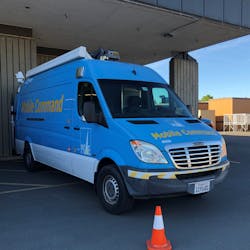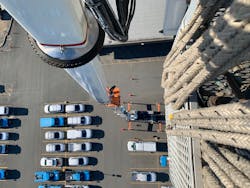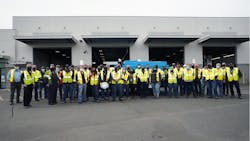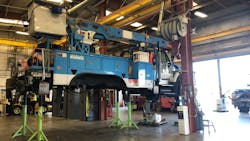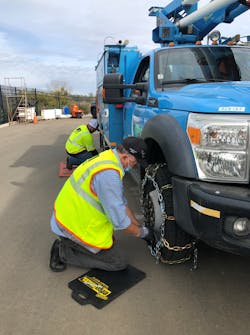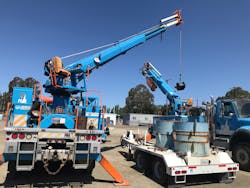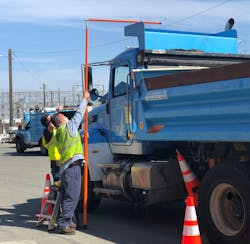Electric vehicles and other alternative fuels have been piquing Jameson Reichert’s interests since he can remember. The engineering major designed a solar-powered boat for his senior design project at Cedarville University in 2007. Fifteen years later, he has a much bigger project on his hand: Electrifying Pacific Gas & Electric, the largest regional utility fleet in the U.S.
“Back then, that was still not exactly a mainstream thing,” the Michigan native told FleetOwner of his early forays into zero emissions. So, he had to head out west to pursue a future in clean transportation. “PG&E seemed like it was at the forefront of that industry, so it seemed like the perfect opportunity to come out here to California.”
See also: Meet the 2022 FleetOwner 500 Private Fleets of the Year
Reichert is now a senior fleet engineer for PG&E, which has one of the largest battery-electric fleets in North America. The 49th largest commercial private fleet in the U.S. provides transportation services for the 117-year-old utility provider. Based in Oakland, the company has more than 5 million customers in central and northern California.
PG&E, the 49th largest fleet on the FleetOwner 500: Private Fleets, was named the overall 2022 Best Private Fleet by FleetOwner editors. The fourth-largest utility fleet in the U.S., PG&E is firmly committed to sustainability. Its work in California is laying the groundwork for fleets across the country that will be working to reduce emissions in the coming years. The award is sponsored by Isaac Instruments.
About 1,200 of its vehicles run on battery-electric or hybrid systems, with another 60 on compressed natural gas (CNG), according to Michael Glover, senior director of transportation services for PG&E. The fleet also supports a network of 1,200-plus vehicle charging points at 114 locations.
“PG&E’s is privileged to deliver safe, reliable, affordable, and clean electric and gas services to 16 million residents in the greater northern and central California regions,” he told FleetOwner. “PG&E’s service territory spans 70,000 square miles, operating in coastal, metro, and mountainous terrains.”
Glover said he’s most proud of the learning and engagement he’s accomplished with his team through the first-generation EV technology his fleet uses and is grateful for the technicians who persevered, adapted, and are vocal about the challenges the fleet must overcome with the incoming second-generation EV technology.
As it develops that next generation of clean-fleet technology, PG&E created specification review committees that bring in operators, technicians, engineers, and other employees to get early buy-in from the people operating, maintaining, and designing the fleet.
All of PG&E’s medium- and heavy-duty diesel vehicles met or exceeded California’s 2007 on-road diesel vehicle regulations standards for particulate levels by the end of 2016, Glover said. “All vehicles in our fleet met 2010 standards for nitrogen oxide emissions by the end of 2018—five years ahead of the 2023 CARB (California Air Resources Board) regulatory requirement.”
But the giant fleet has bigger clean-energy goals ahead. These include converting all its light-duty, 50% medium-duty, and 20% heavy-duty vehicles to EVs by 2030. Its traditional power vehicles have already made significant strides this decade, Glover added. The fleet converted about 2.7 million gallons of conventional diesel to renewable diesel, which reduced 17,731 metric tons of CO2 in 2021.
“It’s exciting and it’s a challenge,” Glover said of California’s push to decarbonize the commercial vehicle industry. “There may not be a clear path to get there right now—but the path will emerge at some point. And I feel fortunate that I’m on a team that’s pioneering that path at the scale that we’re able to do it at.”
Leading the charge to zero
A self-proclaimed “EV nerd,” Reichert’s personal cars have been EVs since 2015. He helps PG&E plan out its vehicle procurement and life cycles. “It’s all coming together now,” he said. “OEMs are finally offering more electric vehicles. The California Air Resources Board now has the Advanced Clean Fleet Rule, which is still in draft language, but it’s going to be the major driving force with our fleet. Because it’s really easy to electrify your light-duty fleet—but the heavy-duty fleet is exponentially harder, especially in a utility sense.”
While other fleets making strides in electrification can plan out their vehicles’ routes each day, utility companies need to be designed to react. “Our employees maybe know their job a day or two ahead of time—but it’s so variable,” Reichert said. “One day they could be responding to a storm, another day they can be halfway across the state doing something completely different. So that’s another level of difficulty.”
The CARB clean fleet goals include lofty targets to remove diesel-powered vehicles from California's roads by mid-century. But Reichert said that PG&E doesn’t feel forced into alternative fuels. “These regulations are kind of aligned with the company’s goals,” he explained. “Granted, they are aggressive targets, and our main concern is availability from OEMs.”
OEMs have told Reichert and his team it could take a few years before medium-duty and larger EV chassis can be upfit with PG&E’s needs. “Well, we don’t really have a few years,” he said. “But it’s a challenge I figure is the culmination of my career. I’ve wanted to do this for so long. It’s a pretty awesome career goal to electrify most of the PG&E fleet.”
Most medium-duty EV chassis coming to market are aimed more at delivery fleets than utilities, which require auxiliary power units to run the hydraulic systems, compressors, and electrical power. Typically, a Class 5 chassis holds these “trouble trucks,” as PG&E calls them. They’re the vehicles that respond to downed power lines or other outages. The current trouble trucks get fuel mileage similar to a Class 8 tractor-trailer. Often they are stationed overnight at operators’ homes so they can respond immediately to emergencies.
Not only does the utility and its partner OEMs have to figure out how to power that 19,000-lb. truck, but it has to create a home-charging network as well. “If I could grab the battery pack from a Tesla Semi and shove it into a pickup truck, maybe I could make it work—but I’m hoping technology finds a path to that one,” Reichert said.
For now, PG&E is focusing on half-ton pickups and other light-duty vehicles to meet its 100% EV goal by the decade’s end. He was expecting the fleet’s first deliveries of the Ford F-150 Lighting to arrive soon. “We’re super jazzed to get those and finally put them in the fleet,” Reichert said.
See also: Ford Pro: Lightning pilot shows way to grow fleet electrification
The battery-electric Fords PG&E is expecting will all come with the extended-range battery, which offers up to 320 miles on a full charge. Over the years, being among the first in the U.S. to electrify fleet vehicles has taught Reichert and his team that if something goes wrong on the road or a truck with new technology ends up in the shop regularly, the operators and technicians won’t let the fleet’s leaders forget it.
“We want to give our operators the best of the best,” he explained. “If you make a bad impression with something, it will haunt you for a very long time. So it’s very important on the management aspect to educate them ahead of time, get your mechanics on board with training, and understand what these are. The more stakeholders you bring in early—instead of just forcing a vehicle on them—pays huge dividends.”
Maintaining today and tomorrow’s fleet
As it adopts more clean transportation technologies, PG&E is also grappling with the industry’s technician shortage. The utility created a new hiring program in 2021 that drew more than 1,000 applicants for jobs in its more than 60 garages. The fleet hired 43 new mechanics last year.
“I’m excited for the new workforce that’s coming in,” Glover said. “ The new workforce is bringing a lot of new talent and at the same time is adding to their skills by learning from the best of the best in the industry, our experienced PG&E mechanics. They’re also bringing a lot of industry experience, feedback, and solutions as we get into this kind of next wave of technology.”
Luvpri Thandi, PG&E’s San Francisco area fleet operations supervisor, oversees four locations with 28 employees and about 1,100 pieces of equipment. Like other private fleet managers, he said it was difficult to find new technicians because most didn’t know that PG&E managed its own fleet. “Plus, there’s a huge cost-of-living expense in the Bay Area,” he added.
He said the fleet would get more technician applicants from outside the Bay Area. “People would come in just to get the PG&E job experience—then as soon as they have the ability, they would find another job closer to home.”
To help combat this, PG&E’s recruiters began advertising the fleet’s pay and benefits, which Thandi said are higher than most operations in the area. “We started getting a lot more applicants, especially those well qualified for what we were looking for,” he told FleetOwner. “Over the past year now, we’ve had a lot more applicants that live closer to the Bay Area.”
And to combat the revolving door of technicians that PG&E dealt with in years past, Thandi said the company now tries its best to place new hires in one of its 64 garages closer to their homes.
“All mechanics talk to each other,” he added. “So we started getting a huge influx of applicants as soon as they realized that not only is this a good company to work for, but it’s going to be around for a long time—and it pays better than my current job.”
While his shop hasn’t worked on many alternative-fuel vehicles besides some hybrid trucks, Thandi and his team are bracing for an influx of new EV equipment. “There is excitement involved around it,” he said of the fleet’s clean-technology shift. “There’s also a little bit of anxiety because change is not easy—change isn’t supposed to be easy. One of the things I have said to my team is: ‘Adapt and overcome.’”
He’s confident his team will do just that, thanks to the knowledgeable group of technicians already on board. “Sometimes, if you’re scratching your head on something, you just need to reach out for extra support,” Thandi explained. “We have multiple mechanics who have been around for 20-plus years—and they know this stuff blindfolded. Give them a call. We do that regularly. I’m sure we’re going to face new challenges with the shift to electric vehicles—but we’ll make it happen.”
Safety summits
Working together goes beyond the PG&E maintenance bays. The Transportation Services Grass Roots Safety team established safety summits for 350 team members over more than 30 sessions last year. The meetings include activities such as hands-on backing awareness and blind-spot exercises, spotting defects on pre-bugged assets, and performance on driver vehicle inspection reporting (DVIR).
Natasha Marinaro, PG&E’s East Bay Area fleet operations supervisor, had just conducted a safety summit in late April when she took some time to speak to FleetOwner.
“The summits are awesome because it’s a hands-on experience,” she said. “We do exercises and have leadership out here leading by example, partnering with everyone. And it’s everyone. It’s not just field operations. We’ve got business operations, we’ve got the engineers with us, we got the behind-the-scenes teams. Everybody in the department comes out, and they commit to going to one safety summit a year.”
For PG&E, it’s all about being prepared. Before the technicians start any task, they go over the job, make sure they have all the tools to complete it, go over any barriers that could prevent the job’s completion, and even assess their own mental and physical state.
“The guys take it very seriously. They know their job is critical,” Marinaro said. “We are putting trucks on the road. And I always ask them: ‘Would you allow that truck to be on the road and put your family in front of it?’ Because essentially, that’s the mindset you need to have. The public needs to know that we are doing our job 100% efficiently, effectively, and safely.”
Open, speak-up culture
From safety to innovation, Marinaro said that PG&E thrives under an open culture. “It’s not just an open culture—it’s a speak-up culture,” she explained. “It’s not just that everyone's encouraged; they’re expected to speak up if something seems unsafe.”
Glover credited that culture for helping the fleet find its emerging path toward decarbonization. PG&E’s specification review committees rely on the openness of team members as they move to create and integrate the next generation of zero-emissions vehicles. For him, it’s all about engaging his fleet stakeholders in the future.
“We’re balancing out the operators’ view with the engineering view with the mechanics’ view,” he explained. “It all helps to get a better product once we’re done as opposed to one person developing them in a silo and hoping that they got the solution right after a long production cycle.”
Reichert, senior fleet engineer, said this collaboration of PG&E stakeholders is building something special. “The best is yet to come,” he said. “I think we’re finally getting to the inflection point where EVs are going to be deployed more and more, so check back in a few years.”

